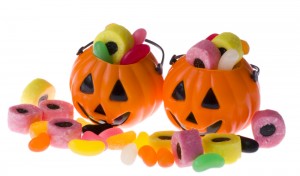 Trick or Treating is now one of the most widely recognized traditions of the Halloween holiday. Children dress up in costume and go from house to house, with a question ”Trick or treat?” as a treat they often get confectionary, occasionally money and the trick is an idle threat to perform mischief on the homeowners property if no treat is given.
Trick or Treating is now one of the most widely recognized traditions of the Halloween holiday. Children dress up in costume and go from house to house, with a question ”Trick or treat?” as a treat they often get confectionary, occasionally money and the trick is an idle threat to perform mischief on the homeowners property if no treat is given.
In England and Ireland a form of trick or treating began many years ago in the form of souling, where children would go from door to door singing and saying prayers for the dead in return for cakes.
There is no evidence that souling was ever practiced in North America, where trick-or-treating may have developed independent of any Irish or British antecedent.
Whatever it’s origins it is now a popular activity in, Mexico, Western Europe, Scandinavia, and in more recent years in Australia and New Zealand.
A few years ago The National Confectioners Association carried out a survey, detailing that 80% of adults in the United States planned on giving out confectionary to trick or treaters and that 93% of children planned on going trick or treating.
In Ireland, Scotland and northern parts of England guising is traditional, so called guising because of the disguises or costumes worn by the children.
Trick or Treat is now the recognised phrase, but that has come about mainly by due to the influence of American popular culture, movies, and television. Irish children would have said “Help the Halloween Party”, in Waterford “attin far Halloween”, in Quebec, Canada they simply say “Halloween” or more traditionally – La charité s’il-vous-plaît meaning charity please.
Tweet